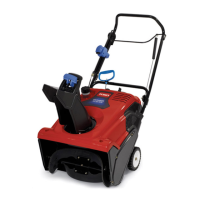
Do you have a question about the Toro Power Clear 621 QZR and is the answer not in the manual?
| Brand | Toro |
|---|---|
| Model | Power Clear 621 QZR |
| Category | Snow Blower |
| Language | English |
Identifies the safety alert symbol used for hazard warnings.
Explains words used to highlight important information in the manual.
Alerts to potential personal injury hazards and safety messages.
Warns about amputation and object throwing hazards associated with the machine.
Emphasizes understanding controls and quick stopping procedures.
Covers area inspection, appropriate clothing, and fuel handling.
Details safe practices for refueling, static prevention, and fuel storage.
Outlines safe practices to follow during snowthrower operation.
Advises caution when operating on gravel drives and slopes.
Instructs to stop and inspect the machine after striking objects.
Highlights abnormal vibration as a sign of potential trouble.
Mandates operation with all guards and safety devices in place.
Warns of potential injury from rotating rotor blades.
Requires stopping the engine and removing the key before service.
Stresses replacing damaged safety devices and decals.
Advises caution regarding hot engine and muffler surfaces.
Limits maintenance to instructions provided in the manual.
Prohibits changing the engine governor settings.
Recommends draining fuel for storage exceeding 30 days.
Warns of injury from hand contact with rotating blades in the chute.
Details steps to safely clear a clogged discharge chute.
Emphasizes using a clean-out tool, not hands, for clearing.
Recommends frequent checks for fastener tightness.
Prohibits storing with fuel indoors near ignition sources.
Advises running the engine briefly to prevent parts from freezing.
Stresses the importance of safety decals and replacing damaged ones.
Identifies specific decals for Model 38458.
Identifies specific decals for Model 38459.
Instruction to verify all parts have been shipped before assembly.
Details steps for unfolding and positioning the handle.
Warns against pinching or kinking control and Quick Shoot cables.
Details the procedure for installing the discharge chute.
Warns against overtightening screws to prevent damage.
Step-by-step guide for filling the engine with the correct oil.
Emphasizes filling engine oil before starting the machine.
Advises on correct oil level to avoid overfilling or underfilling.
Suggests tipping the machine forward for easier oil addition.
Warns against tipping the machine onto its nose to prevent fuel leaks.
Details the procedure for adjusting the control cable.
Instructs on how to remove slack from the control cable.
Specifies the required gap between the control bar and handle.
Explains why slack is necessary for proper stopping function.
Identifies key components of the snowthrower via diagram.
Highlights dangers of gasoline flammability and explosion.
Advises on grounding to prevent static ignition during fueling.
Recommends purchasing fresh fuel and proper storage.
Specifies acceptable and restricted gasoline types.
Warns against tipping the machine with fuel in the tank.
Specifies checking oil level before each use or daily.
Details steps for checking and adding engine oil.
Warns against tipping machine to avoid fuel leakage.
Details turning the ignition key and engaging the choke lever.
Instructs on correctly using the primer bulb.
Warns against using primer/choke on a hot engine.
Instructions for initiating the engine start using the electric start button.
Notes on using appropriate UL-listed extension cords for starting.
Warns of shock or fire risk from damaged electrical cords.
Advises on limits for electric starter use to prevent damage.
Provides advice if the recoil starter feels frozen.
Guides on gradually pushing the choke lever in as the engine warms.
Instructs to unplug the electric cord after the engine starts.
Warns against leaving the machine plugged into a power source.
Describes how to engage the rotor blades using the control bar.
Describes how to disengage the rotor blades by releasing the control bar.
Instructs on how to stop the engine using the ignition key.
Explains how to change the discharge chute's direction.
Details how to adjust the angle of the chute deflector.
Reiterates the hazard of hand contact with rotating blades.
Provides a step-by-step guide for safely clearing a clogged chute.
Details actions to prevent moving parts from freezing after use.
Methods to prevent recoil and electric starters from freezing.
Advises on handling frozen controls in cold, snowy conditions.
Warns about rotor blades throwing objects and causing injury.
Ensures the clearing area is free of objects that could be thrown.
Recommends prompt snow removal after it falls.
Guidance for pushing the machine in slippery conditions.
Suggests overlapping swaths for complete snow removal.
Advises discharging snow downwind whenever possible.
Provides a schedule for essential maintenance tasks.
Details how to check the control cable for proper function.
Step-by-step guide to adjust control cable slack.
Explains why slack is necessary for the rotor blades to stop.
Mentions potential drive belt wear and slip in wet conditions.
Details yearly inspection and replacement criteria for rotor blades.
Explains how to identify worn rotor blades using the indicator hole.
Provides service intervals for changing engine oil.
Covers warming the engine and preparing for oil draining.
Advises on proper disposal of used engine oil at a recycling center.
Specifies yearly inspection and replacement recommendations for spark plugs.
Details spark plug removal, gap setting, and installation.
Warns against cleaning electrodes; advises replacement of faulty plugs.
Steps for removing the shroud, fuel cap, and chute components.
Covers shroud, fuel cap, and chute reinstallation.
Details setting the correct spark plug gap.
Specifies torque for installing the spark plug.
Identifies when the drive belt needs replacement due to wear or damage.
Steps for removing and installing the drive belt.
How to release belt tension using the brake spring.
Steps for removing the rotor pulley and drive belt.
Guidance on routing and installing the new drive belt.
Steps for installing the rotor pulley and securing it.
Ensures proper drive belt adjustment and operation.
Procedure to adjust slack in the Quick Shoot cable.
How to position the Quick Shoot control correctly.
Ensures proper alignment of the discharge chute.
Fine-tuning cable slack for smooth operation.
Caution against over-tensioning the control cables.
Detailed steps for preparing and storing the snowthrower.
Highlights hazards of storing gasoline-powered equipment.
Prohibits storing near ignition sources or in living areas.
Steps for draining fuel and conditioning the fuel system.
Adds oil to the cylinder for long-term storage protection.
Instructions for cleaning and protecting metal surfaces.
Final check of fasteners and damaged parts before storage.
Ensures clean, dry storage and engine cooling before storing.

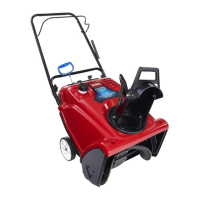

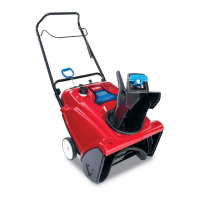
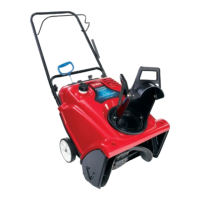

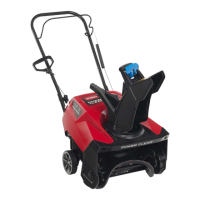
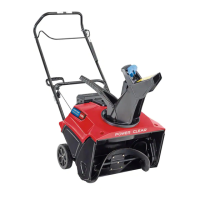

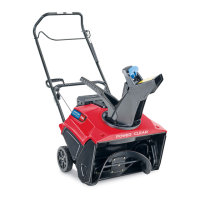
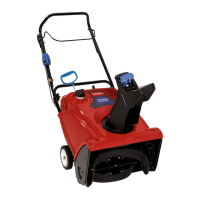

